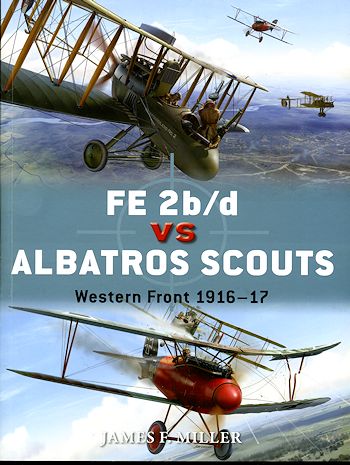 Always a
delight to get to read another addition to Osprey's Duel series. This time, it
moves to WWI and the air with the two antagonists being the RAF Fe.2b/d and the
other the Albatros Scout.
Always a
delight to get to read another addition to Osprey's Duel series. This time, it
moves to WWI and the air with the two antagonists being the RAF Fe.2b/d and the
other the Albatros Scout. |
Author: |
James F. Miller |
|
Publisher/Distributor |
Osprey Publishing |
|
Price |
$18.95 MSRP |
|
Reviewer: |
|
| Notes: |
80 pages, 7¼ x 9¼ inches, softcover ISBN: 978-1-78096-325-9 |
 Always a
delight to get to read another addition to Osprey's Duel series. This time, it
moves to WWI and the air with the two antagonists being the RAF Fe.2b/d and the
other the Albatros Scout.
Always a
delight to get to read another addition to Osprey's Duel series. This time, it
moves to WWI and the air with the two antagonists being the RAF Fe.2b/d and the
other the Albatros Scout.
The first on the scene was the Fe.2. This, along with the DH.2 and some others, was a pusher aircraft, this sort of arrangement being due to the British not having a proper interrupter gear so rather than mounting the gun on the top of the wing, the plan was to have the front of the plane offer a clear field of fire. This was managed by putting the engine behind the crew in a pusher configuration.
The aircraft was also a two seater with the gunner/observer in the front position. There was no protection from enemy fire so his life expectancy was shorter than that of the pilot. He also had two guns on movable mounts. One faced forward and the other was aimed over the top of the wing to take care of planes coming from the rear. On some Fe.2s, there was a third gun facing forward. Despite what seems like a cumbersome arrangement, the aircraft was fairly successful and even after its time of ascendency was over, it was still used for reconnaissance and light bombing roles.
On the other side of the coin was the Albatros Scout. This aircraft had a fuselage skinned in plywood and was a very sleek design for the day. Thanks to using a powerful Mercedes engine (previously only used on two seat recce planes), and the use of an interrupter gear to keep the guns synchronized not to shoot off the prop, the Albatros was able to mount two forward firing Maxim guns. The Albatros also had the benefit of being a single seat plane so was pretty much superior to its adversary in all modes of flight.
The Albatros range went from the D.I to D.II, to D.III (which was built in greater numbers than the other two) to the D.V. When Albatros went from the D.II to the D. III, it tried the sesquiplane planform. This is where the lower wing was significantly smaller than the upper wing. This helped to lighten the aircraft, but was also the cause of some issues causing wing failure in dives. Albatros scouts were the mount of several famous German Aces, including Manfred von Richtofen, who was not only the top Fe.2 killer with 12, but was also nearly killed himself in combat with an Fe.2 when a bullet grazed his skull and forced him to crash land his Albatros. The book goes into some detail regarding this event and comes to the conclusion that he may have been hit by friendly fire.
Anyway, like all aircraft in the first war, technology rapidly advanced, making the Albatros obsolesent within a year or so of its introduction, though some units flew the plane up until near the end of the war. The Fe.2 was replaced earlier than that by the DH.2 and later by the Se.5 and Pup.
In all, it is a well rounded book that covers the strategic situation of the time, the development of both aircraft and the operational use of them. There are a lot of pilot stories and a bevy of excellent period photos making this a 'must have' book for fans of the era. A book I very much enjoyed reading and one that I can highly recommend to you.
February 2014
For more on the complete line of Osprey books, visit www.ospreypublishing.com. In the US, it is Osprey Direct at 443 Park Avenue South, New York, NY 10016, where you can get a catalogue of available books.
If you would like your product reviewed fairly and quickly, please contact me or see other details in the Note to Contributors.